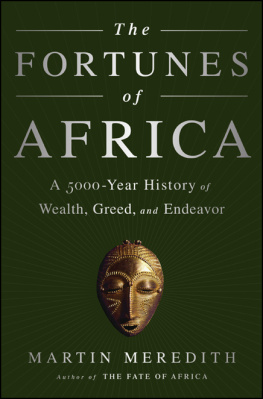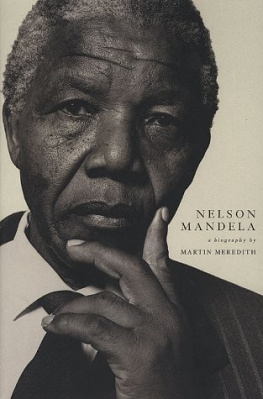THE FORTUNES OF
AFRICA
Martin Meredith is a journalist, biographer, and historian who has written extensively on Africa and its recent history. His previous books include Mandela; Mugabe; Diamonds, Gold, and War; Born in Africa; and The Fate of Africa. He lives near Oxford, England.
Copyright 2014 by Martin Meredith.
First published in Great Britain by Simon & Schuster UK Ltd, 2014
A CBS COMPANY
Published in 2014 in the United States by PublicAffairs, a Member of the Perseus Books Group All rights reserved.
No part of this book may be reproduced in any manner whatsoever without written permission except in the case of brief quotations embodied in critical articles and reviews. For information, address PublicAffairs, 250 West 57th Street, 15th Floor, New York, NY 10107.
PublicAffairs books are available at special discounts for bulk purchases in the U.S. by corporations, institutions, and other organizations. For more information, please contact the Special Markets Department at the Perseus Books Group, 2300 Chestnut Street, Suite 200, Philadelphia, PA 19103, call (800) 810-4145, ext. 5000, or e-mail special.markets@perseusbooks.com.
Maps by ML Design
Typeset in the UK by M Rules Library of Congress Control Number: 2014939816
ISBN 978-1-61039-460-4 (EB) First Edition
10 9 8 7 6 5 4 3 2 1
CONTENTS
List of Maps
Preface
Introduction
PART I
1Land of the Pharaohs
2Venture into the Interior
3A Clash of Empires
4Death on the Nile
5Roman Interlude
PART II
6Saints and Schisms
7The Arab Conquest
8Highways of the Desert
9Zanj
PART III
10A Chain of Crosses
11In the Land of Prester John
12The Middle Passage
13Southern Frontiers
PART IV
14Mamluks and Ottomans
15The Black Guard
16The Sword of Truth
17A Matter of Faith
PART V
18The Gates of Africa
19The Pasha
20Pieds Noirs
21Bibles, Ploughs and Bullets
PART VI
22Masters and Servants
23The People of the Heavens
24Republics on the Highveld
25The Missionaries Road
PART VII
26The Tunes of Zanzibar
27Unlocking the Congo
28The Pearl of Africa
29A Game of Thrones
PART VIII
30The Khedive
31Equatoria
32Delegate of the People
33The Expected One
PART IX
34Diamond Fever
35The Fellowship of Afrikaners
36The Washing of Spears
37A Chosen People
38The Most Powerful Company in the World
PART X
39This Magnificent Cake
40Spheres of Interest
41The Eagle and the Lion
42Carving up the Niger
43By Right of Conquest
PART XI
44New Flower
45Omdurman
46A Desert Fraternity
PART XII
47Bula Matari
48The Rubber Regime
PART XIII
49A Tale of Two Towns
50The Road to Ophir
51Marching to Pretoria
52The Extermination Order
PART XIV
53Interregnum
54A Veiled Protectorate
55Elect of God
56The Goal of Mastery
57The Turn of the Tide
PART XV
58Before the Deluge
59Revolution on the Nile
60The Nationalist Urge
61Gone with the Wind
62An Honourable Exit
63The Congo Bet
64In the Name of Apartheid
PART XVI
65The First Dance of Freedom
66Coups and Dictators
67Lost Decades
68Liberation Wars
69In Search of Democracy
70Soldiers of God
71Platinum Life
Chapter Notes
Picture Permissions
Select Bibliography
Index
LIST OF MAPS
Map 1Africa in 2014
Map 2Egypt and Nubia
Map 3Highways of the Desert
Map 4Land of Zanj
Map 5West Africa
Map 6Land of Prester John
Map 7Southern Africa
Map 8Egypts Empire
Map 9Africa on the Eve of the Scramble
Map 10East Africa
Map 11Congos Heart of Darkness
Map 12Africa in 1914
Map 13Africa in 1954
Map 14Africa at Independence
Africa in 2014
PREFACE
Ever since the era of the pharaohs, Africa has been coveted for its riches. The pyramids of the Nile Valley dazzled the rest of the world not just because of the ingenuity of their architects and builders but as symbols of the wealth of Egypts rulers who commissioned them as stepping stones to the afterlife.
Legends about Africas riches endured for millennia, drawing in explorers and conquerors from afar. Stories in the Bible about the fabulous gifts of gold and precious stones that the Queen of Sheba brought King Solomon during her visit to Jerusalem in the tenth century BCE grew into folklore about the land of Ophir that inspired European adventurers in their quest for gold to launch a war of conquest in southern Africa 3,000 years later.
Land was another prize. The Romans relied on their colonies in north Africa for vital grain shipments to feed the burgeoning population of Rome; they named one of their coastal provinces Africa after a Berber tribe known as the Afri who lived in the region of modern Tunisia. Arab invaders followed in the wake of the Romans, the first wave arriving in the seventh century, eventually supplanting indigenous chiefdoms across most of north Africa; they used the Arabic name Ifriqiya to cover the same coastal region.
When European mariners began their exploration of the Atlantic coastline of Africa in the fifteenth century, they applied the name to encompass the whole continent. Their aim initially was to find a sea route to the goldfields of west Africa which they had learned was the location from where camel caravans carrying gold set out to cross the Sahara desert to reach commercial ports on Africas Mediterranean coast. Their interest in the west African goldfields had been stimulated as the result of a visit that the ruler of the Mali empire, Mansa Musa, paid to Cairo in 1324 while making a pilgrimage to Mecca. He was so generous in distributing gold that he ruined the money markets there for more than ten years. European cartographers duly took note. A picture of Mansa Musa decorates the Catalan Atlas of 1375, one of the first sets of European maps to provide valid information about Africa. A caption on the map reads: So abundant is the gold that is found in his country that he is the richest and most noble king in all the land. Modern estimates suggest that Mansa Musa was the richest man the world has ever seen, richer even than todays billionaires.
Another commodity in high demand from Africa was slaves. Slavery was a common feature in many African societies. Slaves were often war-captives, acquired by African leaders as they sought to build fiefdoms and empires and used as labourers and soldiers. But the long-distance trade in slaves, lasting for more than a thousand years, added a fearful new dimension. From the ninth century onwards, slaves from black Africa were regularly marched across the Sahara desert, shipped over the Red Sea and taken from the east coast region and sold into markets in the Levant, Mesopotamia, the Arabian peninsula and the Persian Gulf. In the sixteenth century, European merchants initiated the transAtlantic trade to the Americas. Most of the inland trade in slaves for sale abroad was handled by African traders and warlords. Fortunes were made at both ends of the trade. By the end of the nineteenth century, the traffic in African slaves amounted in all to about 24 million men, women and children.
Next page











